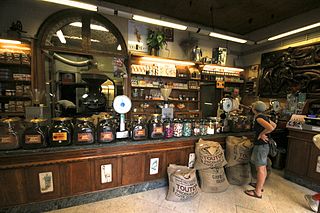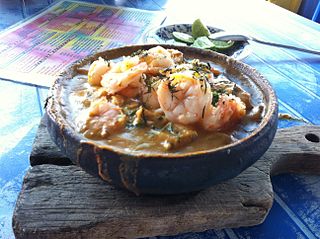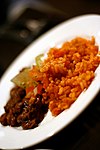
Mexican cuisine consists of the cooking cuisines and traditions of the modern country of Mexico. Its earliest roots lie in Mesoamerican cuisine. Its ingredients and methods begin with the first agricultural communities such as the Olmec and Maya who domesticated maize, created the standard process of nixtamalization, and established their foodways. Successive waves of other Mesoamerican groups brought with them their cooking methods. These included: the Teotihuacanos, Toltec, Huastec, Zapotec, Mixtec, Otomi, Purépecha, Totonac, Mazatec, Mazahua, and Nahua. With the Mexica formation of the multi-ethnic Triple Alliance, culinary foodways became infused.

Spanish cuisine consists of the traditions and practices of Spanish cooking. It features considerable regional diversity, with important differences between the traditions of each part of Spain.

Espresso is one of the most popular coffee-brewing methods, of Italian origin. The French also made a significant contribution to the invention of the first coffee makers, predecessors of today's espresso machines, and generally to the café culture. Espresso can be made with a wide variety of coffee beans and roast degrees, in which a small amount of nearly boiling water is forced under pressure through finely-ground coffee beans. Espresso is the most common way of making coffee in southern Europe, especially in Italy, France, Spain, Portugal and Greece, but it is also popular in the rest of the world.

Italians are well known for their special attention to the preparation, the selection of the blends, and the use of accessories when creating many types of coffees. Many of the types of coffee preparation known today also have their roots here. The main coffee port in Italy is Trieste where there is also a lot of coffee processing industry. Italian coffee consumption, often espresso, is highest in the city of Trieste, with an average of 1500 cups of coffee per person per year. That is about twice as much as is usually drunk in Italy.

Caffè latte, often shortened to just latte in English, is a coffee drink of Italian origin made with espresso and steamed milk. Variants include the chocolate-flavored mocha or replacing the coffee with another beverage base such as masala chai, mate, matcha, turmeric or rooibos; alternatives to milk, such as soy milk or almond milk, are also used.

Turkish coffee is a style of coffee prepared in a cezve using very finely ground coffee beans without filtering.

Aguardente (Portuguese), or aguardiente (Spanish), is a type of distilled alcoholic spirit that contains between 29% and 60% alcohol by volume (ABV). It is a somewhat generic term that can refer to liquors made from various foods. It originates from and is typically consumed on the Iberian Peninsula and in Iberian America.
Ponche crema is a cream-based liqueur that originates in Venezuela and was brought to nearby Trinidad and Tobago who developed their own version, Ponche de Crème. Recipes vary depending on the region, but main ingredients typically include milk, eggs, sugar, rum, and other minor ingredients such as vanilla, nutmeg, cinnamon, and lemon rind. A variant type is prepared with concentrated liquid coffee or instant coffee powder. However, most references to the ponche crema name aim at a traditional commercial product, available since 1900, whose recipe and manufacturing process are kept secret. Ponche crema is a beverage traditionally served during Christmas time, much as eggnog is in the United States. It is usually served cold, in small cups, either as an aperitif or a pousse-café.

Café Cubano is a type of espresso that originated in Cuba. Specifically, it refers to an espresso shot which is sweetened. However, the name is sometimes used to refer to coffee based drinks that include Cuban espresso as the main ingredient, such as café con leche.

Colombian Americans, are Americans who trace their ancestry to Colombia. The word may refer to someone born in the United States of full or partial Colombian descent or to someone who has immigrated to the United States from Colombia. Colombian Americans are the sixth-largest Latin American group and the largest South American Hispanic group in the United States.

Macedonian cuisine is the traditional cuisine of North Macedonia. It is influenced by Ottoman and Balkan cuisines. The relatively warm climate of the country provides excellent growth conditions for a variety of vegetables, herbs and fruits. Macedonian cuisine is also noted for the diversity and quality of its dairy products, wines, and local alcoholic beverages, such as rakija. Tavče gravče and mastika are considered the national dish and drink of North Macedonia.

Cazuela is the common name given to a variety of dishes, especially from South America. It receives its name from the cazuela – traditionally, an often shallow pot made of unglazed earthenware used for cooking. The ingredients and preparation vary from region to region, but it is usually a mid-thick flavoured stock obtained from cooking several kinds of meats and vegetables mixed together.

The Habesha coffee ceremony is a core cultural custom in Ethiopia and Eritrea. There is a routine of serving coffee daily, mainly for the purpose of getting together with relatives, neighbors, or other visitors. If coffee is politely declined, then tea will most likely be served.

Caffè d'orzo or barley coffee is a type of hot drink, originating in Italy. Orzo is a caffeine-free roasted grain beverage made from ground barley. It is an espresso-style drink, and when prepared from the roasted barley directly, it can easily be made in typical espresso machines and coffeemakers. In Italy it is widely available in coffee vending machines. Although traditionally considered a coffee substitute for children, it is an increasingly common choice in Italy and other places for those who choose to eschew caffeine for health reasons.

A chorreador is a coffee making device used in Costa Rica in which hot water leaches through coffee grounds held in a cloth filter mounted on a wooden stand, then drips into a container.

Oaxacan cuisine is a regional cuisine of Mexico, centered on the city of Oaxaca, the capital of the eponymous state located in southern Mexico. Oaxaca is one of Mexico's major gastronomic, historical, and gastro-historical centers whose cuisine is known internationally. Like the rest of Mexican cuisine, Oaxacan food is based on staples such as corn, beans and chile peppers, but there is a great variety of other ingredients and food preparations due to the influence of the state's varied geography and indigenous cultures. Corn and many beans were first cultivated in Oaxaca. Well known features of the cuisine include ingredients such as chocolate, Oaxaca cheese, mezcal and grasshoppers (chapulines) with dishes such as tlayudas, Oaxacan style tamales and seven notable varieties of mole sauce. The cuisine has been praised and promoted by food experts such as Diana Kennedy and Rick Bayless and is part of the state's appeal for tourists.

Arroz a la tumbada is a traditional Mexican dish prepared with white rice and seafood. In this specialty a sofrito is made with chopped tomato, onion, garlic and red pepper. Rice and fish broth or water is added, then seafood which may include shrimp, clams, crab, calamari and whitefish. The dish may be seasoned with fresh leaves of epazote, parsley, coriander and oregano. Arroz a la tumbada is traditionally cooked in a cazuela, which is a thick clay pot.

Cielito Querido Café is a Mexican coffee shop chain inspired by Latin American history that sells typical Mexican beverages and foods. Brenda Montero is the current CEO of the company. The brand vends typical Mexican products including chamoyadas, hot horchata, café de olla, ponche, and sweet bread.



























